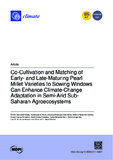| dc.contributor.author | Awala, Simon Kamwele | |
| dc.contributor.author | Hove, Kudakwashe | |
| dc.contributor.author | Valombola, Johanna Shekupe | |
| dc.contributor.author | Nafuka, Helena Nalitende | |
| dc.contributor.author | Simasiku, Evans Kamwi | |
| dc.contributor.author | Chataika, Barthlomew | |
| dc.contributor.author | Horn, Lydia Ndinelao | |
| dc.contributor.author | Angombe, Simon | |
| dc.contributor.author | Akundabweni, Levi S. M. | |
| dc.contributor.author | Mwandemele, Osmund D. | |
| dc.date.accessioned | 2023-12-04T12:55:57Z | |
| dc.date.available | 2023-12-04T12:55:57Z | |
| dc.date.issued | 2023-11-10 | |
| dc.identifier.uri | https://doi.org/10.3390/cli11110227 | |
| dc.identifier.uri | https://www.mdpi.com/2225-1154/11/11/227 | |
| dc.identifier.uri | http://ir-library.mmust.ac.ke:8080/xmlui/handle/123456789/2421 | |
| dc.description.abstract | In semi-arid regions, climate change has affected crop growing season length and sowing time, potentially causing low yield of the rainfed staple crop pearl millet (Pennisetum glaucum L.) and food insecurity among smallholder farmers. In this study, we used 1994–2023 rainfall data from Namibia’s semi-arid North-Central Region (NCR), receiving November–April summer rainfall, to analyze rainfall patterns and trends and their implications on the growing season to propose climate adaptation options for the region. The results revealed high annual and monthly rainfall variabilities, with nonsignificant negative trends for November–February rainfalls, implying a shortening growing season. Furthermore, we determined the effects of sowing date on grain yields of the early-maturing Okashana-2 and local landrace Kantana pearl millet varieties and the optimal sowing window for the region, using data from a two-year split-plot field experiment conducted at the University of Namibia—Ogongo Campus, NCR, during the rainy season. Cubic polynomial regression models were applied to grain-yield data sets to predict grain production for any sowing date between January and March. Both varieties produced the highest grain yields under January sowings, with Kantana exhibiting a higher yield potential than Okashana-2. Kantana, sown by 14 January, had a yield advantage of up to 36% over Okashana-2, but its yield gradually reduced with delays in sowing. Okashana-2 exhibited higher yield stability across January sowings, surpassing Kantana’s yields by up to 9.4% following the 14 January sowing. We determined the pearl millet optimal sowing window for the NCR to be from 1–7 and 1–21 January for Kantana and Okashana-2, respectively. These results suggest that co-cultivation of early and late pearl millet varieties and growing early-maturing varieties under delayed seasons could stabilize grain production in northern Namibia and enhance farmers’ climate adaptation. Policymakers for semi-arid agricultural regions could utilize this information to adjust local seed systems and extension strategies. | en_US |
| dc.language.iso | en | en_US |
| dc.publisher | Climate | en_US |
| dc.subject | Co-Cultivation, Matching, Early- and Late-Maturing, Pearl, Millet, Varieties, Sowing, Windows, Enhance Climate-Change, Adaptation, Semi-Arid, Sub-Saharan, Agroecosystems | en_US |
| dc.title | Co-Cultivation and Matching of Early- and Late-Maturing Pearl Millet Varieties to Sowing Windows Can Enhance Climate-Change Adaptation in Semi-Arid Sub-Saharan Agroecosystems | en_US |
| dc.type | Article | en_US |

